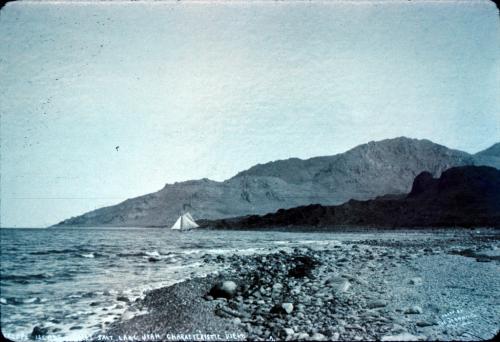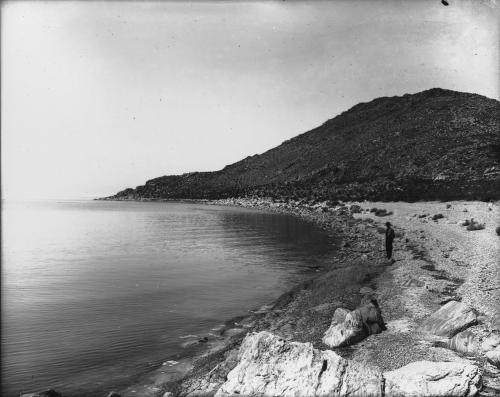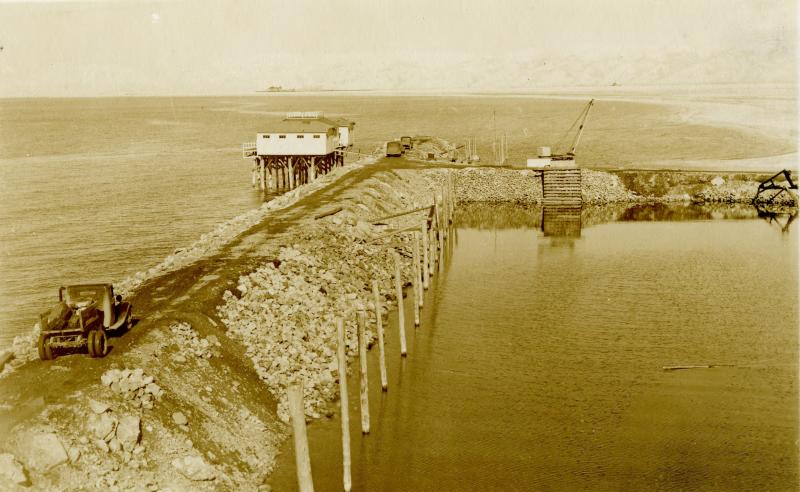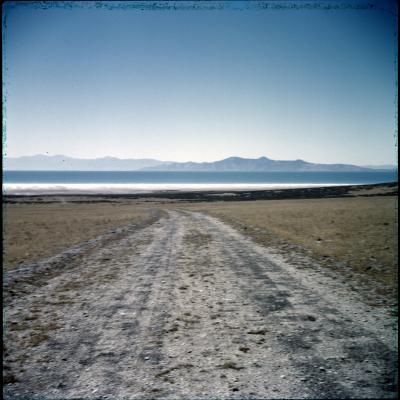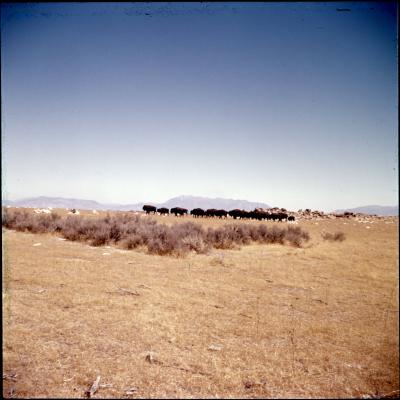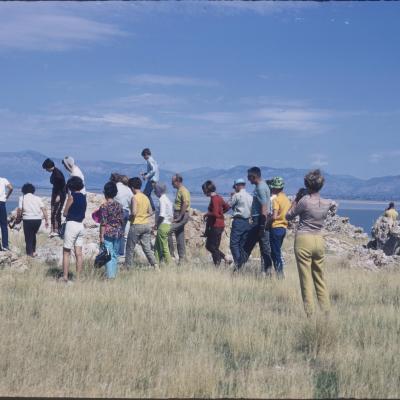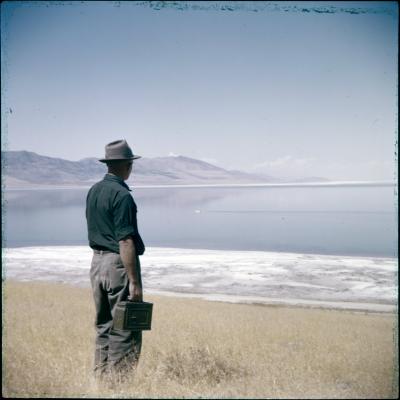Antelope Island
Antelope Island is the largest island of the Great Salt Lake, measuring about 15 miles long and five miles wide. The Western Shoshone called it Pari-bi-na for "elk place; elk breeding place". The island is in the southeastern part of the south arm, and becomes a peninsula with low lake levels. The island has traditionally served as habitat for pronghorn, bighorn sheep, badger, coyote, mule deer, jack rabbits, bald eagles, native grass communities, big sagebrush, juniper, gambel oak, and was right on the edge of the historic range of the American bison. The island was a resource gathering site and part of the traditionally associated homelands of the Western Shoshone, Goshute, and Ute peoples. The first euro-americans to visit the island were John C Fremont and Kit Carson, who explored the Lake in 1845 and named the island after a pronghorn they shot and killed. The core of the island is mountainous, while the north, east, and south sides feature rolling alluvial plains. In the late 19th Century the island was used as a ranch for cattle and sheep, and bison were re-introduced in 1893. The north end of the island was purchased by the state in 1969, with the rest of the island added in 1981 to form Antelope Island State Park. The state park saw a surge of visitation during the covid-19 pandemic, with annual visitation topping one million visitors for the first time in 2020.
Ellen was born and raised in Riverside, Illinois. She graduated from Utah State University in Recreational Resource Management. She has worked as a ranger for the Utah State Parks department for more than twenty years. Ellen talks about her early interest in the outdoors and how she got involved with the Parks department. She tells about her time spent at Starvation Reservoir, Jordanelle State Park, Antelope Island State Park and Willard Bay State Park, including her duties and responsibilities. She relates favorite stories about her time at Antelope Island and reveals her favorite spots on the island, and closes the interview with her feelings about the lake and its value. In this clip, she talks about the annual bison roundup.
In this clip, Ellen Labotka discusses some of her day-to-day duties at Antelope Island State Park, including coordinating volunteers.
Genevieve Atwood and Don Mabey discuss their involvement with the Great Salt Lake. They talk about their early experiences with the lake, and when and why they became interested in it. They describe their educational training and interests in science. Atwood discusses her career with the Utah Geological Survey, her contribution to several boards involved with the Great Salt Lake, and her time in the Utah State Legislature. She describes many of the lake’s important historical and geographical features, and the lake’s processes. She talks about her involvement in the management of the lake. Don talks about his work helping manage and plan for the Great Salt Lake. Atwood discusses the high lake level times, as well as many of the plans to control the lake level. In the second interview, Atwood talks about the causeway and its effects on the Great Salt Lake. She discusses the high lake level years. She describes the map of the Great Salt Lake that she, Mabey, and Don Currey designed and produced. Atwood talks about leaving the UGS and her time in the state legislature. She talks about the management of Great Salt Lake. She details the educational work she does with teachers and students about and at the Great Salt Lake. Don and Genevieve talk about their favorite places and experiences at the Great Salt Lake.
Don Paul was born in Cedar City, Utah. He was raised in Clearfield and graduated from Weber State University. He later worked as a conservation officer for the Utah Division of Wildlife Resources, and then as an information specialist. He also worked on a television program called “Utah Trails” and participated in writing a book on raptors in Utah. Don was the first non-game manager in Utah for the DWR and was the principal biologist for the reintroduction of Peregrines to northern Utah. He then became Chief of the Information Education Section before becoming a wildlife biologist for the Great Salt Lake. Don also became the first avian biologist with the Great Salt Lake Ecosystem Project. In this interview, Don talks about his formative years and his parents’ influence on his love of the outdoors. He also talks about his first experiences exploring the Great Salt Lake. He discusses his education, which led him to a career as a biologist. He also discusses the Great Salt Lake’s ecological diversity, complexity, and importance, and compares it with other similar ecosystems in the world. Mr. Paul goes on to discusses the changes he has seen to the Great Salt Lake, as well as challenges to its ecosystem. He also describes his work with the Linking Communities Program.
In this clip, Don Paul talks more about his experiences on Antelope Island.
Bonnie Baxter is a professor of biology at Westminster College in Salt Lake City and the director of the Great Salt Lake Institute. Fascinated by science from a young age, she pursued work in genetics and DNA. Her interest has always been in liberal arts education, which is how she found Westminster College, and, in turn, began her relationship with the Great Salt Lake. She studies halophiles (salt-loving bacteria) and works with people of widely divergent backgrounds who are also interested in the Lake. Through the Great Salt Lake Institute, she has encouraged interdisciplinary relationships between people all over the world. Dr. Baxter discusses her work with the Lake at some length and shares her favorite areas. She also emphasizes the importance of interaction with the ecosystem and believes strongly that children need to be involved with that interaction.
John Neill was born in Pittsburgh and raised in South Ogden. Growing up, he and his family recreated frequently at Great Salt Lake and on Antelope Island. After graduating from Bonneville High in Ogden, John earned a degree in geology and environmental studies from Whitman College in Walla Walla, Washington, and did seasonal work at the Great Salt Lake. After completing a second bachelor’s degree in biology at the University of Utah, John was hired full-time at the Division of Wildlife. John now works for the Utah Division of Wildlife Resources’ bird aspect of the Great Salt Lake Ecosystem Program. He also works with the local nonprofit Linking Communities, Wetlands, and Migratory Birds. In this interview, John talks extensively about his work at the GSL. He discusses the lake’s hemispheric significance for bird migration, the brine shrimp industry, and threats to various bird populations.


